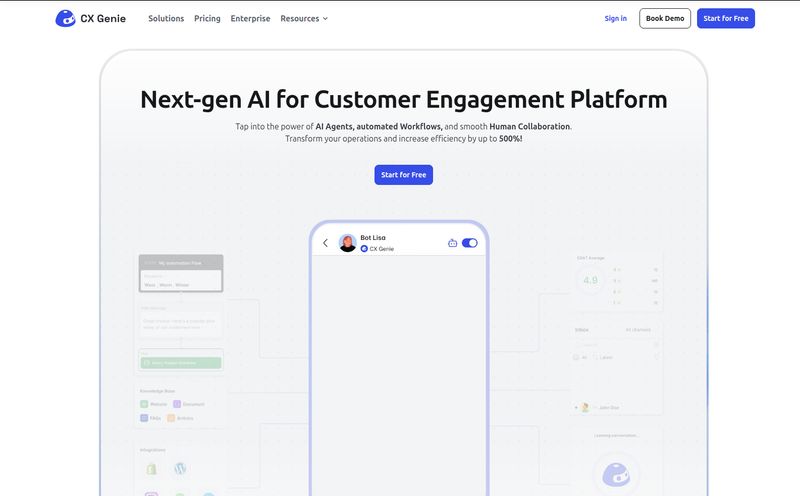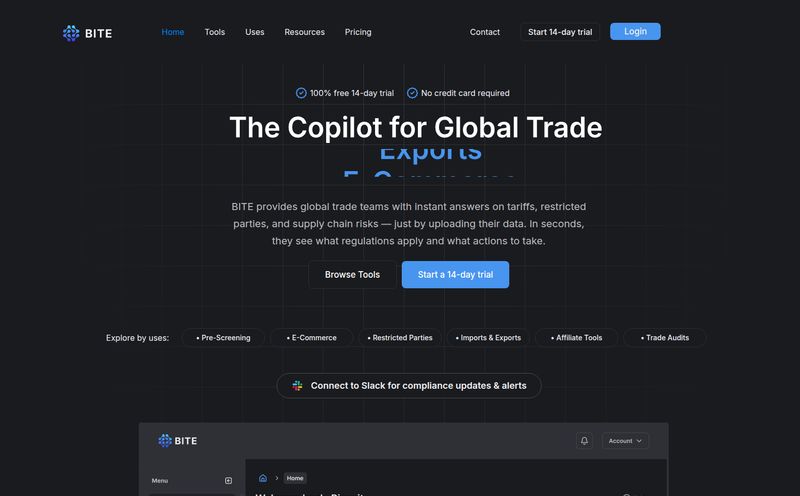If you've ever managed a project in construction, mining, or even just complex facilities management, you've known the soul-crushing dread of paperwork. Specifically, safety paperwork. The Safe Work Method Statement (SWMS), the Job Hazard Analysis (JHA), the Risk Assessment… it's a mountain of forms that can feel like you're trying to build a skyscraper out of paper before you can even break ground.
For years, this has been my reality. Countless hours spent poring over templates, trying to remember every single potential hazard for a new task, and then typing it all up. It’s tedious, it's repetitive, and there's always that nagging fear in the back of your mind: Did I miss something?
So, when I first heard about SWMS AI, my inner skeptic raised an eyebrow. An AI that writes your safety docs? In seconds? Sure, Jan. We've all seen a million 'AI-powered' tools that are just glorified templates. But I'm also a tech geek at heart, and the promise of automating the worst part of my job was just too tempting to ignore. I had to give it a shot.
So What Exactly is This SWMS AI Thing?
At its core, SWMS AI is an artificial intelligence platform designed to automate the creation of safety compliance documents. Think of it as a hyper-intelligent assistant who has memorized every safety regulation, code of practice, and potential hazard known to man.
You give it a description of a high-risk job—say, 'installing solar panels on a sloped residential roof'—and it doesn't just pull up a generic template. It analyzes the task and generates a comprehensive, job-specific Safe Work Method Statement. It identifies the hazards (working at heights, electrical risks, manual handling), assesses the risk level, and then—and this is the cool part—proposes concrete control measures. All in a matter of seconds.
Putting It To The Test: My First Run-Through
Signing up was straightforward, no credit card required for the trial, which I always appreciate. The interface is clean, almost deceptively simple. There's a box that basically says, 'Tell me what you're doing.'
I decided to throw it a curveball, something with a few moving parts. I typed in:
Operating an excavator to dig a 3-meter trench for plumbing lines next to an existing residential structure.
I hit 'Generate,' expecting a short wait. But it was fast. Almost unnervingly fast. What it produced was… impressive. It wasn't just a list of 'don't do this.' It generated a structured SWMS document that included:
- High-Risk Activities: Trenching, operating heavy machinery, working near structures.
- Potential Hazards: Trench collapse, striking underground utilities, destabilizing the nearby foundation, noise, dust.
- Control Measures: Shore up trench walls, 'Dial Before You Dig' procedures, establish an exclusion zone, mandatory hearing protection, water spraying for dust suppression.
It even included sections for PPE requirements and emergency procedures. It was a document that would have taken me a solid hour, at least, to draft from scratch. And it was a damn good first draft.

Visit SWMS AI
The Features That Actually Matter
Beyond the main generator, a few things stood out to me as genuinely useful, not just marketing fluff.
Meet Oscar, Your AI Safety Guru
Tucked into the platform is an AI assistant named 'Oscar.' Think of it like a safety-specific ChatGPT. Instead of googling "what are the regulations for scaffolding in California?" and sifting through a dozen government websites, you can just ask Oscar. The real value here is context. Oscar is trained on safety data, so its answers are focused and relevant. I’ve found it handy for those quick, on-the-fly questions that pop up during the day.
Customization is King
This is a big one for larger outfits. SWMS AI isn't a locked box. You can customize the outputs to align with your own company's specific safety policies and procedures. For a safety manager trying to standardize compliance across multiple teams or sites, this is huge. It ensures that the AI-generated documents speak the same language as your internal safety manual, which is critical for adoption and real-world application.
The Alphabet Soup of Safety Docs
On their site, you see a bunch of acronyms: JHA, SWP, RAMS, SDS. For those in the trenches, you know these are all slightly different beasts. What's nice is that the platform understands this. It's not a one-trick pony just for SWMS. It's designed to be a central hub for generating various types of safety documentation, from a quick Job Hazard Analysis to a full-blown Risk Assessment Method Statement.
Let's Talk Money: The Pricing Plan
Okay, the bottom line. SWMS AI runs on a subscription model. The Standard Plan is $14.99 per month. For that price, you get to create unlimited safety risk assesments.
Is it worth it? Let's do some quick back-of-the-napkin math. How much do you value your time at? Or your safety officer's time? If this tool saves you even one hour a month, it has paid for itself multiple times over. When you think about the time saved on a single, complex project, the ROI becomes a no-brainer. It's priced for accessibility, which tells me they're aiming for broad adoption, from solo contractors to larger firms.
The Good, The Bad, and The AI
No tool is perfect, and it’s important to see both sides. After spending some time with it, here’s my balanced take.
What I Genuinely Liked
The speed is the obvious win. It turns a half-day task into a coffee-break task. But more than that, it acts as an incredible safety net. The AI often brings up hazards or control measures you might not have thought of immediately. It democratizes safety knowledge, making high-level expertise accessible to everyone on the team, not just the senior safety manager. I've always said the best safety tool is one people will actually use, and its simplicity is a major plus.
A Few Things to Keep in Mind
Now, for the reality check. The AI is powerful, but it’s not a mind reader. The quality of the output is directly proportional to the quality of your input. If you just type "digging," you'll get a generic output. You need to provide a detailed, descriptive prompt to get a truly useful, site-specific document. This is a tool for professionals, not a magic wand.
It’s also crucial to remember that this is an assistant, not a replacement for human oversight. You should always review and refine the AI-generated document. The final sign-off, the final responsibility, still rests with a competent human being. That’s a feature, not a bug.
Who Is This Really For?
I see a few key groups getting massive value from this.
- Small to Medium Contractors: For companies that don't have a full-time, dedicated safety department, this is a game-changer. It gives you the power of a safety expert for the price of a streaming subscription.
- Safety Managers in Large Firms: This tool doesn't replace you; it makes you more efficient. It handles the grunt work, freeing you up to focus on higher-level strategy, training, and site inspections—the stuff that actually prevents accidents.
- Project Managers & Site Supervisors: The people on the ground who need to get docs done now. This allows them to quickly generate reliable drafts without having to chase down the safety officer for every new task.
My Final Verdict: Is SWMS AI a Must-Have?
After my initial skepticism, I've come around. SWMS AI isn't just another piece of software; it feels like a genuine step forward in how we manage workplace safety. It's a force multiplier. It takes the most tedious, time-consuming part of safety compliance and automates it with surprising intelligence.
It won't replace the need for experienced, on-the-ground safety professionals. But it will make them better, faster, and more effective at their jobs. It reduces the friction of compliance, which ultimately leads to safer worksites for everyone. For me, it has earned a permanent place in my digital toolbox. It's a rare example of AI that doesn't just promise to make work easier—it actually delivers.
Frequently Asked Questions
1. What exactly is a Safe Work Method Statement (SWMS)?
A SWMS is a legal document required for high-risk construction work in many countries, like Australia. It outlines the specific tasks to be performed, identifies the potential hazards associated with those tasks, and describes the control measures that will be put in place to keep workers safe.
2. Can I trust an AI with something as important as safety?
You should view SWMS AI as an expert assistant, not a final authority. The AI is trained on vast amounts of safety data, standards, and regulations, making its suggestions highly relevant. However, the best practice is always to have a competent person review, edit, and approve any safety document before work begins. It’s a tool to augment human expertise, not replace it.
3. What industries is SWMS AI best suited for?
The platform is designed for any industry involving high-risk activities. This includes Construction, Mining, Oil and Gas, Transportation, Warehousing, and Facilities Management. Essentially, if you need to create risk assessments or method statements, it can probably help you.
4. How does the free trial work?
According to their website, you can sign up for the Standard Plan trial without a credit card. This gives you a chance to test the platform's core features, like creating unlimited risk assessments and accessing the AI assistant Oscar, to see if it's a good fit for your needs before committing to a paid subscription.
5. Is my project data kept private?
While I can't speak for the company's internal servers, their website has a Privacy Policy and an 'Integrations With Your Data' page. For any business tool handling potentially sensitive project information, it's always a good idea to review these policies or contact the company directly to understand how your data is stored and used.
Reference and Sources
- SWMS AI Official Website - For pricing and feature information.
- Occupational Safety and Health Administration (OSHA) - For more information on Job Hazard Analysis (JHA).
- Safe Work Australia - For official guidance on Safe Work Method Statements (SWMS).



